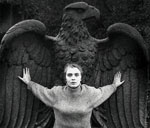
Dave Godin, in writing about his beloved Deep Soul, argued that it incorporated ďsound acting ability in addition to vocal talent, in order to come across as Ďthe real thingí.ď He had a point. You need only listen to the performances Jerry Williams coaxed out of Doris Duke on, say, 'I Donít Care Anymore' to understand how itís a virtuoso display of dramatics.
Otto Preminger was quite a character, and coaxed actors to give the deepest of performances for films he produced and directed. His characters could mesmerise and haunt you in the self-same way as the deepest soul ballad. Thereís a great book called OK You Mugs, which is essentially a collection of writings on actors and acting, which studiously ignores the obvious stars. Thereís a lovely piece by Patti Smith on Jeanne Moreau, and you donít often catch me saying that about Patti Smith. Her piece starts with a great line like no one could smoke a cigarette like Jeanne. Intriguingly two of the essays make explicit reference to Premingerís 1944 film noir Laura. In one, Charles Simic writes about falling in love with Gene Tierney as Laura in a Paris cinema, while in the other Geoffrey OíBrien writes about becoming obsessed with Laura the film just as Dana Andrews in the film becomes obsessed by Laura.
Premingerís casting was spot on. He picked Jean Seberg out of nowhere to be his Saint Joan in the 1956 film. He would then cast her as Cecile in his adaptation of Francoise Saganís Bonjour Tristesse, where she was the exquisite foil to David Nivenís playboy. Somehow these films failed to capture the publicís imagination, and it would be appropriately in France that she became the face of many a dream. Itís well documented how Preminger-fan Jean-Luc Godard chose her for the role of Patricia in his immortal A Bout De Souffle (Breathless), and how this film and the French New Wave it was part of changed the course of cinema. It was the casting of Jean that really made it all work.
I remember a Paul Morley interview with Edwyn Collins, where he commends the singer to us for understanding the significance of Simon Toppingís haircuts. That may seem a relatively shallow thing to say, but it needed saying. As the frontman for A Certain Ratio Toppingís haircuts were complete art statements, as integral to the appeal of the group as the fractured funk they created. You donít just need to take my word for it. There are plenty of photos around, and archivists LTM have salvaged an early video of A Certain Ratio for the Umbrellas In The Sun DVD which is completely captivating.

The other film Jean Seberg appeared in to just as devastating effect was Lilith in 1964, where she takes on the character of a beautifully bewitching schizophreniac, who captivates her occupational therapist until reality and fantasy become blurred, and a seemingly simple smile becomes a strangely sinister thing. This is where the art of the cinema really comes into its own, and allows us to read so much into a particular movement or mannerism.
Slightly more orthodox success came at the end of the Ď60s for Jean with Paint Your Wagon and Airport. She was at the same time very much involved in political activity, and outspokenly supported the civil rights movement, and was widely thought to be a financial supporter of the Black Panther Party. It was this activity that particularly incensed the FBI and J Edgar Hoover, and prompted its Counter Intelligence Programme to conduct a smear campaign against Jean while she was expecting. The core of the campaign was to plant gossip among the press in Hollywood suggesting she was pregnant by a prominent Black Panther. This campaign affected Jeanís emotional stability, and the baby was born prematurely, tragically dying shortly afterwards. This would haunt Jean for the rest of her days, right through to her death in 1979. It was only then that the FBI admitted that it had spread the rumour that it could be argued ultimately destroyed Jean.
It could have been The Night And The City, and Gene Tierney luminescent in the adaptation of the classic Gerald Kersh London noir novel, but instead Iím thinking back to a very young Charles Simic sitting in that Parisian cinema, mesmerised by the beautiful but troubled Gene Tierney. And it reminds me of my own teenage self, sitting alone in a Hampstead repertory cinema, having made the pilgrimage to see Jean Seberg in A Bout De Souffle. I was completely entranced, and it was everything I wanted it to be. I thought Jean, her gangster boyfriend Jean Paul Belmondo, and everything about the film were the very epitome of cool. It all fitted perfectly into my idealised world, where Vic Godard was the most important person, the most enigmatic of pop characters. And if Vic was prompted to take that stage name then it seemed only right I should make the connection to Jean-Luc Godard and seek out his films.
I made that pilgrimage in very different times. As technology moves on it becomes increasingly easy to access information and products. DVDs of A Bout De Souffle are widely available, and other Jean-Luc Godard films too. As I write, some stores are practically giving away copies of his Le Mepris. Fantastic photos of and information about Jean Seberg are freely available on the internet. All I could find after seeing A Bout De Souffle back then though was a postcard of Jean which Iíve treasured to this day. It shows her with arms akimbo underneath the shadow of a huge American eagle, staring intently into the camera. Make of that what you will.
© 2006 John Carney